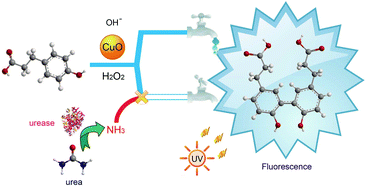Alkaline peroxidase activity of cupric oxide nanoparticles and its modulation by ammonia†
Abstract
We herein report the intrinsic alkaline peroxidase-like activity exhibited by CuO nanoparticles when 3-(4-hydroxyphenyl)propionic acid was employed as a substrate. Based on this observation, a fluorometric assay method with a low detection limit of 0.81 μM was established for H2O2 determination under alkaline conditions. Notably, ammonia was found to inhibit the alkaline peroxidase-like activity of the CuO nanoparticles. Thus, a sensing platform for the determination of urea and urease was successfully constructed, with the limits of detection for urea and urease being 27 μM and 2.6 U L−1, respectively. This platform was then applied for the detection of urea in human urine and urease in soil, which yielded satisfactory results. These results suggest that it is possible to extend the catalytic potential of peroxidase and its mimetics from acidic and neutral conditions to include activity in alkaline media as well. Furthermore, this strategy is a novel method for the analysis of urea and urease. The assay developed in this work is facile, inexpensive, convenient, and highly selective and sensitive. Therefore, it is expected that this system can serve as a template for the development of similar enzyme nano-mimics.



 Please wait while we load your content...
Please wait while we load your content...